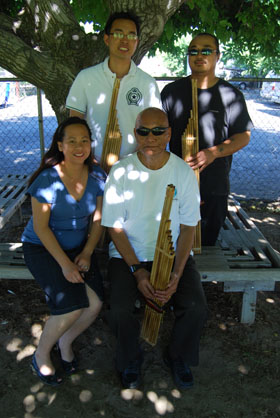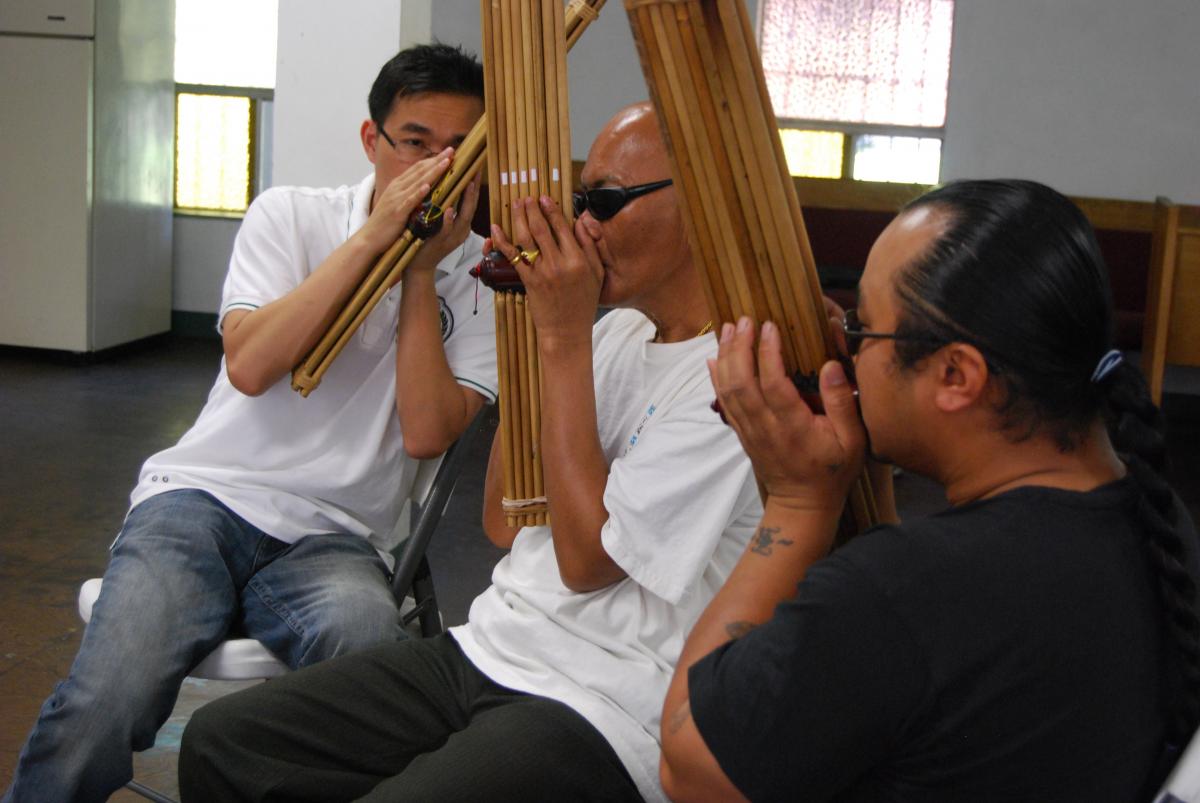 If you are ever in search of a Lao community, all you have to do is follow the sounds of the khene, and you will surely find yourself surrounded by a culture filled with wonderful and rich traditional music. Of all our traditional musical instruments, none is as popular or as well respected as the khene (also spelled kaen or khaen).
If you are ever in search of a Lao community, all you have to do is follow the sounds of the khene, and you will surely find yourself surrounded by a culture filled with wonderful and rich traditional music. Of all our traditional musical instruments, none is as popular or as well respected as the khene (also spelled kaen or khaen).
Physically, the khene, a mouth organ, is a very simple instrument constructed from bamboo. However, when you put an experienced player behind the instrument, it can create sounds as soothing and soft as the winds gently blowing between bamboo stalks in our faraway country of Laos, or as fast and upbeat as a “top 10” pop song. This instrument of choice is often played at significant events such as weddings, baci ceremonies, house-warming parties, and festivals.
I was first introduced to the khene by my father, who has loved this instrument for as long as I can remember. He often played the khene in the late evening after dinner outside on our front porch. Reflecting back, I believe the music my father played on the khene was like therapy for his soul; it made him happy. So it was natural that while growing up, this instrument became a part of my life.
At the age of 9, I was a member of a Lao traditional dance and musical group led by Jon Ching. My parents, amongst a total group of about 15-20 Lao individuals, would perform dances and songs locally in Fresno and periodically traveled within California to festivals and other events to share a bit of our culture with the general community. At this time, I also had the privilege of meeting the well-known khene master artist, and also my father’s teacher, Bounseung Synanohn. Master Bounseung has been playing the khene since the age of 12. He often shares his story of his passion for wanting to learn this instrument so desperately back home in Laos that he would follow a khene artist around his village. He would then hide and mimic the sounds the artist would play. So, through a combination of this self-learning and his dedication to practice hours at a time, Master Bounseung became one of the best khene players in his village and, ultimately, in the United States. In 1987, Master Bounseung performed for President Reagan at the White House. He also recorded with the World Music Institute under the direction of Terry Miller, a world-renowned ethnomusicologist. In 2007, he performed at the Smithsonian Folklife Festival in Washington, D.C.
Now, in the present, as I became preoccupied with college and then my career, it has been some time since I last worked with Master Bounseung. So it comes as a blessing that about 2 years ago, I was introduced to Xai Souphom from the Lao Heritage Foundation, a nonprofit organization based in Washington D.C. that is striving to preserve the Lao culture through the arts. Xai is a huge fan and student of Master Bounseung, and through our meetings he stroked my interest in starting a khene workshop for Lao youth in hope of passing on skills in this traditional instrument. Therefore, in 2007, with the donation of khene instruments from the Lao Heritage Foundation and a grant from the Fresno Arts Council administered by the Alliance for California Traditional Arts, we were able to start a khene workshop in our community with Master Bounseung as the instructor.
 The khene workshop started with about a dozen students. The khene is a very complex instrument to learn because it requires patience, attention to detail, and commitment. Master Bounseung’s top student was Monty Bouasone. One reason for Monty’s success in learning how to play the khene so quickly is his background in music. He plays the electric guitar, piano, keyboard, and sings as well. Everything he has learned was self-taught and so you could say he is very musically gifted. Learning how to play the khene came very naturally for him, and through observing him, you can tell he truly is dedicated to wanting to excel in the khene. When the opportunity came to apply for the current round of the Alliance for California Traditional Arts’ Apprenticeship Program, I immediately thought of Master Bounseung and Monty. Since the khene is such an integral part of our Lao culture, I strongly believe in the importance of preserving such a tradition, so we may pass it on to future generations so they can enjoy and embrace the beautiful sounds and also take pride it what it stands for.
The khene workshop started with about a dozen students. The khene is a very complex instrument to learn because it requires patience, attention to detail, and commitment. Master Bounseung’s top student was Monty Bouasone. One reason for Monty’s success in learning how to play the khene so quickly is his background in music. He plays the electric guitar, piano, keyboard, and sings as well. Everything he has learned was self-taught and so you could say he is very musically gifted. Learning how to play the khene came very naturally for him, and through observing him, you can tell he truly is dedicated to wanting to excel in the khene. When the opportunity came to apply for the current round of the Alliance for California Traditional Arts’ Apprenticeship Program, I immediately thought of Master Bounseung and Monty. Since the khene is such an integral part of our Lao culture, I strongly believe in the importance of preserving such a tradition, so we may pass it on to future generations so they can enjoy and embrace the beautiful sounds and also take pride it what it stands for.
For the past year, Master Bounseung and Monty have been very busy setting aside time to practice and work together on projects. When the weather permits, they practice outside Fresno Interdenominational Refugee Ministries’ (FIRM’s) facility under the mulberry tree every Sunday, or when it gets too hot as Fresno weather is known to do, they can often be found at Master Bounseung’s home. They have already performed as a duet at our annual Lao New Year, at Fresno City College’s AsianFest, and at Fresno State University’s Lao Cultural Night. Monty has even taken the role in teaching young students the khene. Their current project is to record their lessons together and share it with an online community interested in learning how to play the khene.
Even though Master Bounseung and Monty are about three decades apart in age, you may not notice if you listen to their conversations and the beautiful sounds of their khenes when they play. And I am most grateful to be a part of their wonderful story, to be a part of the passing of this tradition from one generation to the next.
For more information on the khene, visit the Lao Heritage Foundation’s website.
